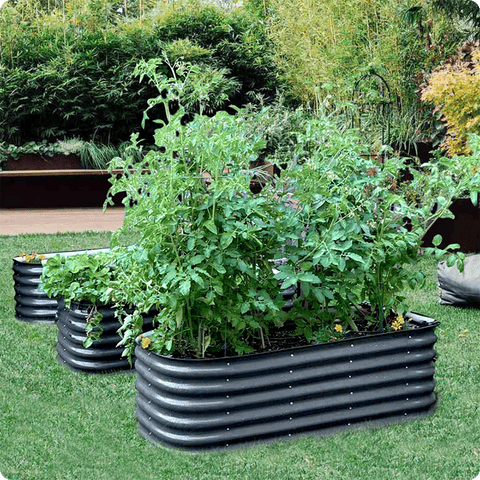Knowledge from Olle Garden Bed: How to Fertilize Your Cucumber Plants
Cucumbers, scientifically known as Cucumis sativus, are a popular choice for home vegetable gardens. To ensure a successful harvest, it's important to follow effective care tips for cucumber plants. The following content also has some reference value for raised garden beds.
Cucumber plants thrive in warm temperatures, typically ranging from 75 to 85 degrees Fahrenheit. They require six to eight hours of sunshine per day and are usually ready to be harvested 50 to 70 days after sowing the seeds. These plants also need an adequate amount of moisture, so it's crucial to irrigate the soil until it feels moist to the touch at a depth of 6 inches.
In addition to warmth, sunlight, and water, cucumber plants can benefit from fertilizer. Using a fertilizer that enriches the soil's nutrients can expedite growth and encourage the production of flavorful cucumbers. Learning how to properly fertilize your cucumber plants will contribute to an outstanding harvest.
Here's what you'll need:
Organic compost
Liquid 5-10-10 fertilizer
Powder, meal, or liquid kelp
Water for irrigating the soil
Step 1: Prepare the soil with organic compost
Incorporating organic compost into the garden soil a few days before sowing seeds or transplanting sprouts is an excellent way to naturally fertilize and improve the soil. The compost should make up about 20 percent of the garden bed or approximately 2 inches deep, mixed into the soil at a depth of 6 to 8 inches. Additionally, side-dress the plants with a handful of compost when vines start to form, and apply it once again after the flowers develop.
Step 2: Use liquid 5-10-10 fertilizer
Liquid 5-10-10 fertilizer is an effective way to provide essential nutrients to your cucumber plants. Apply approximately 3 pounds of liquid fertilizer directly to the soil for every 100 square feet of your garden before planting the cucumbers. You can also enhance the nutrient content of your compost by adding liquid fertilizer to it one to two weeks before incorporating it into the garden bed. Always refer to the package instructions for specific guidelines on fertilizer application.
Step 3: Try kelp fertilizer
Kelp, available in various forms such as powder, meal, or liquid, can be used as a natural alternative to chemical fertilizers. The amount of kelp fertilizer to apply will depend on the type you purchase. It's generally recommended to amend the soil with kelp fertilizer before planting and apply a second application before harvest. Follow the instructions below based on the form of kelp you have:
Kelppowder: Add ¼ to ½ teaspoons per gallon of water and soak the ground.
Kelp meal: Use 1 pound per 100 square feet of cucumber plants and mix it into the soil.
Liquid kelp: Dilute 1 to 2 tablespoons per gallon of water and irrigate the soil.
You can also create a homemade liquid kelp fertilizer by combining kelp meal or powder with water. Mix 2 to 3 cups of dry kelp meal or powder with 1 to 2 cups of water, and then use this mixture to irrigate your plants.
Step 4: Don't forget your container cucumbers
If you're growing cucumbers in containers, they also require a nutrient boost. Before sowing cucumber seeds, create a homemade potting soil blend that contains equal portions of potting soil, organic compost, perlite, and peat moss. Add 1 cup of 5-10-10 fertilizer per 10 gallons of the potting mix and blend thoroughly with a trowel. Apply 5-10-10 fertilizer to your container cucumbers after they start flowering and repeat every three weeks, adjusting the amount according to the size of the container.
It's important to be cautious when using fertilizer to avoid potential problems. Applying too much fertilizer can stunt cucumber growth and result in a low-quality harvest. Excessive amounts of fertilizer can also burn the leaves. Watch for signs of fertilizer burn, such as browning edges on the foliage, wilting or drooping plants, and yellowing leaves.
To avoid fertilizer burn, it's recommended to primarily rely on compost (approximately 2 inches) as the main source of soil nutrients rather than chemical fertilizers. However, if you choose to use liquid fertilizer, always follow the package guidelines and measure the fertilizer correctly.
Remember that there are different ways to fertilize cucumbers, and they can thrive with just one method, such as using compost or liquid fertilizer. However, you can also combine them by adding liquid fertilizer to the compost before amending the soil. If using kelp fertilizer, accompany it with compost or liquid fertilizer to provide a well-rounded nutrient supply.
In conclusion, cucumbers are a delicious and popular vegetable to cultivate in your garden. Properly fertilizing your cucumber plants is an essential part of their care. Whether you choose to use compost, liquid 5-10-10 fertilizer, or kelp to boost soil nutrients, make sure to adjust your application according to the size of your garden or container. Measuring correctly will help prevent fertilizer burn, which can damage the plant and reduce fruit quality.


